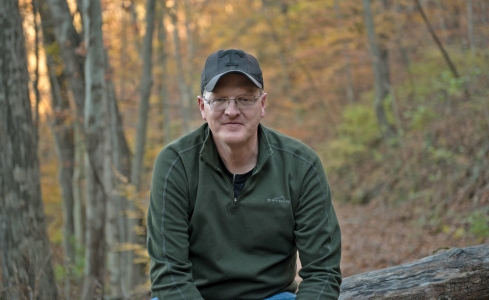David Joy‘s debut novel Where All the Light Tends to Go hit…

Interview with Robert Gipe
Anyone who meets Robert Gipe knows right off that he’s a character in the best sense of the word. Highly creative and original, Gipe has long had an impact on Appalachian culture and literature in his work as the Appalachian program director at Southeast Community and Technical College in Cumberland, Kentucky; as the producer and director of Higher Ground, a series of plays rooted in mountain life; and as a writer whose work has appeared in publications including Appalachian Heritage, Still: The Journal, and Pine Mountain Sand & Gravel. Now Gipe is sharing his creative vision in his debut illustrated novel Trampoline, a book that Ann Pancake has called “one of the most powerful works of contemporary fiction I’ve read in years.” He recently spoke with Appalachian Heritage Student Associate Dylan Mullins about blending the visual and written forms, writing from a female point of view, and watching Squidbillies.
***
Appalachian Heritage: Trampoline has gotten a lot of attention since it was published in March. Are you pinching yourself that it’s finally out in the world?
Robert Gipe: While I haven’t pinched myself, I do stare at the published book for inappropriate lengths of time.
AH: One of the interesting points about this novel is the way in which you accurately depict the spirit of Appalachia. The voice of the character Mamaw displays, as one writer puts it, “your perfect ear for dialect.” But you take this a step further by weaving in drawings throughout the story. Why did you decide to blend the visual with the written art form?
RG: I feel like the drawings, in which the narrator is seen speaking, help emphasize the direct address of the first person narrator to her audience. I wanted to play along the line dividing oral and written language, and the drawings helped me do that. I also thought the drawings might set the book apart from other drawing-free books, and break up the monotony of the prose.
AH: The protagonist, Dawn Jewell, has been described as “a combination of Scout Finch, Huck Finn, Holden Caulfield, and True Grit‘s Mattie Norris.” Did you find it difficult to write from a female point of view?
RG: I have done a fair amount of work with oral history and am very interested in the decisions people make about what to tell strangers. Dawn is an exploration of the choices narrators make about what to share when they are aware that they don’t have any control over who will hear/read their words.
AH: You live in Harlan County, Kentucky—the heart of coal country. Did you have any hesitation to take on the social issues that are in the book, such as mountaintop removal?
RG: Not really. I am interested in the documentary power of fiction, the things it can do to be a record of a time. The stories in the book are based to some extent on things and people I have been involved with over the years. And the social issues examined in Trampoline seemed to me the kind of things people in the future might want to know how human beings dealt with in this era.
AH: The first part of Trampoline was serialized in the online journal Still, and the book is decidedly contemporary. When you were writing the book—and when you decided to share its first chapters digitally—were you conscious of challenging the perception of most Americans that Appalachia is a backward and behind-the-times place?
RG: Well, I mostly wanted the book to work for an Appalachian audience, and that audience pretty much knows what time it is. And what’s more au courant than OxyContin and bigass earth-moving equipment?
AH: Before becoming a published writer, you worked as Marketing and Educational Services Director for Appalshop in Whitesburg, Kentucky. You’re now the director of the Appalachian Program at Southeast Kentucky Community & Technical College. How have these career paths helped to shape your writing?
RG: Because of these jobs, I learned a lot about the history of this region from the people who made it and the people who documented it. And perhaps more importantly, I have been able to live in coalfield communities and mix it up with all kinds of people in an ordinary daily kind of way on all kinds of fronts—and I’ve had a chance to listen to how people tell their own story and how they react to the myriad ways their story gets told by friends, foes, and the well-intended.
AH: What writers have inspired your work? Who are you reading at the moment?
RG: Right now, I’m reading Ann Pancake’s new book, Me and My Daddy Listen to Bob Marley. It’s a beauty, full of great voices and language. Before that I read Queen’s Gambit and Mockingbird by the late, great Kentucky writer Walter Tevis. I’ve been reading manuscripts by my pals Wes Browne and Carrie Mullins. And we did short stories by Jacinda Townsend, Boone Davis, and Tina Louise Blevins in an English class I taught this spring. And I’ve been watching Squidbillies, which I never did before. All I have to say about that is: Lord have mercy.
